1998 CHEVROLET MALIBU fuel cap
[x] Cancel search: fuel capPage 121 of 362
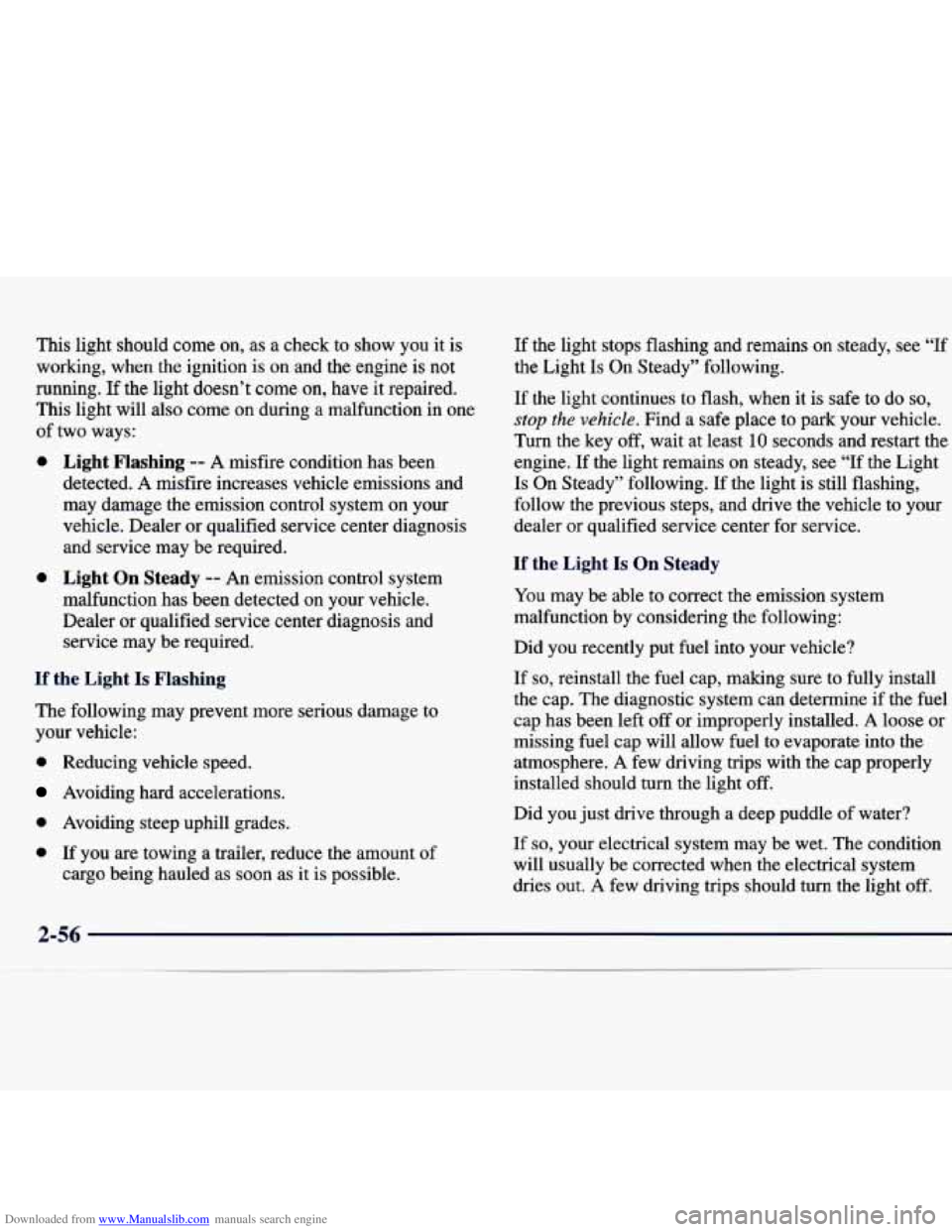
Downloaded from www.Manualslib.com manuals search engine This light should come on, as a check to show you it is
working, when the ignition is on and the engine is not
running. If the light doesn’t come on, have it repaired.
This light will also come on during a malfunction in one
of two ways:
0
0 Light Flashing -- A misfire condition has been
detected.
A misfire increases vehicle emissions and
may damage the emission control system
on your
vehicle. Dealer or qualified service center diagnosis
and service may be required.
Light On Steady -- An emission control system
malfunction has been detected on your vehicle.
Dealer or qualified service center diagnosis and service may be required.
If the Light Is Flashing
The following may prevent more serious damage to
your vehicle:
0 Reducing vehicle speed.
Avoiding hard accelerations.
0 Avoiding steep uphill grades.
0 If you are towing a trailer, reduce the amount of
cargo being hauled as soon as
it is possible. If
the light stops flashing and
remains on steady, see “If
the Light Is On Steady” following.
If the light continues to flash, when it is safe to do so,
stop the vehicle. Find a safe place to park your vehicle.
Turn the key
off, wait at least 10 seconds and restart the
engine. If the light remains on steady, see “If the Light
Is On Steady” following. If the light is still flashing,
follow the previous steps, and drive the vehicle to your
dealer or qualified service center for service.
If the Light Is On Steady
You may be able to correct the emission system
malfunction by considering the following:
Did you recently put fuel into your vehicle?
If
so, reinstall the fuel cap, making sure to fully install
the cap. The diagnostic system can determine if the fuel
cap has been left
off or improperly installed. A loose or
missing fuel cap will allow fuel to evaporate into the
atmosphere. A few driving trips with the cap properly
installed should turn the light off.
Did you just drive through a deep puddle of water?
If so, your electrical system may be wet. The condition
will usually be corrected when the electrical system
dries out.
A few driving trips should turn the light off.
Page 125 of 362
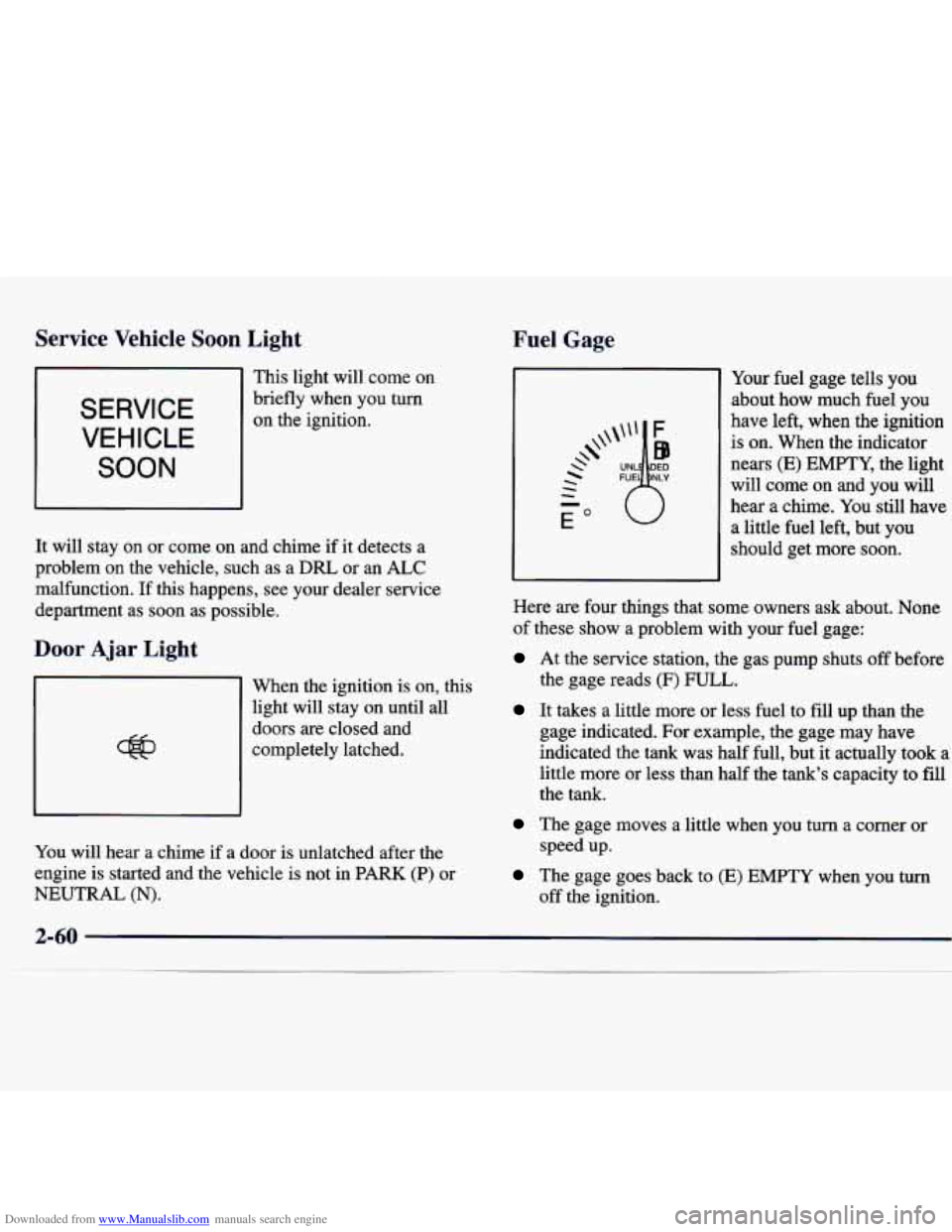
Downloaded from www.Manualslib.com manuals search engine Service Vehicle Soon Light
I1 This light will come on
SERVICE
VEHICLE
SOON briefly when you turn
on the ignition.
It will stay on or come on and chime if it detects a
problem
on the vehicle, such as a DRL or an ALC
malfunction.
If this happens, see your dealer service
department as soon as possible.
Door Ajar Light
When the ignition is on, this
light
will stay on until all
doors are closed and
completely latched.
You will hear a chime if a door is unlatched after the
engine is started and the vehicle is not in
PARK (P) or
NEUTRAL
(N).
Fuel Gage
Your fuel gage tells you
about how much fuel you
have left, when the ignition
is on. When the indicator
nears
(E) EMPTY, the light
will come on and you will
hear
a chime. You still have
a little fuel left, but you
should get more soon.
Here are four things that some owners ask about. None
of these show a problem with your fuel gage:
At the service station, the gas pump shuts off before
the gage reads
(F) FULL.
It takes a little more or less fuel to fill up than the
gage indicated. For example, the gage may have
indicated the tank was half full, but it actually took a
little more or less than half the tank's capacity to fill
the tank.
The gage moves a little when you turn a comer or
The gage goes back to (E) EMPTY when you turn
speed up.
off the ignition.
Page 130 of 362
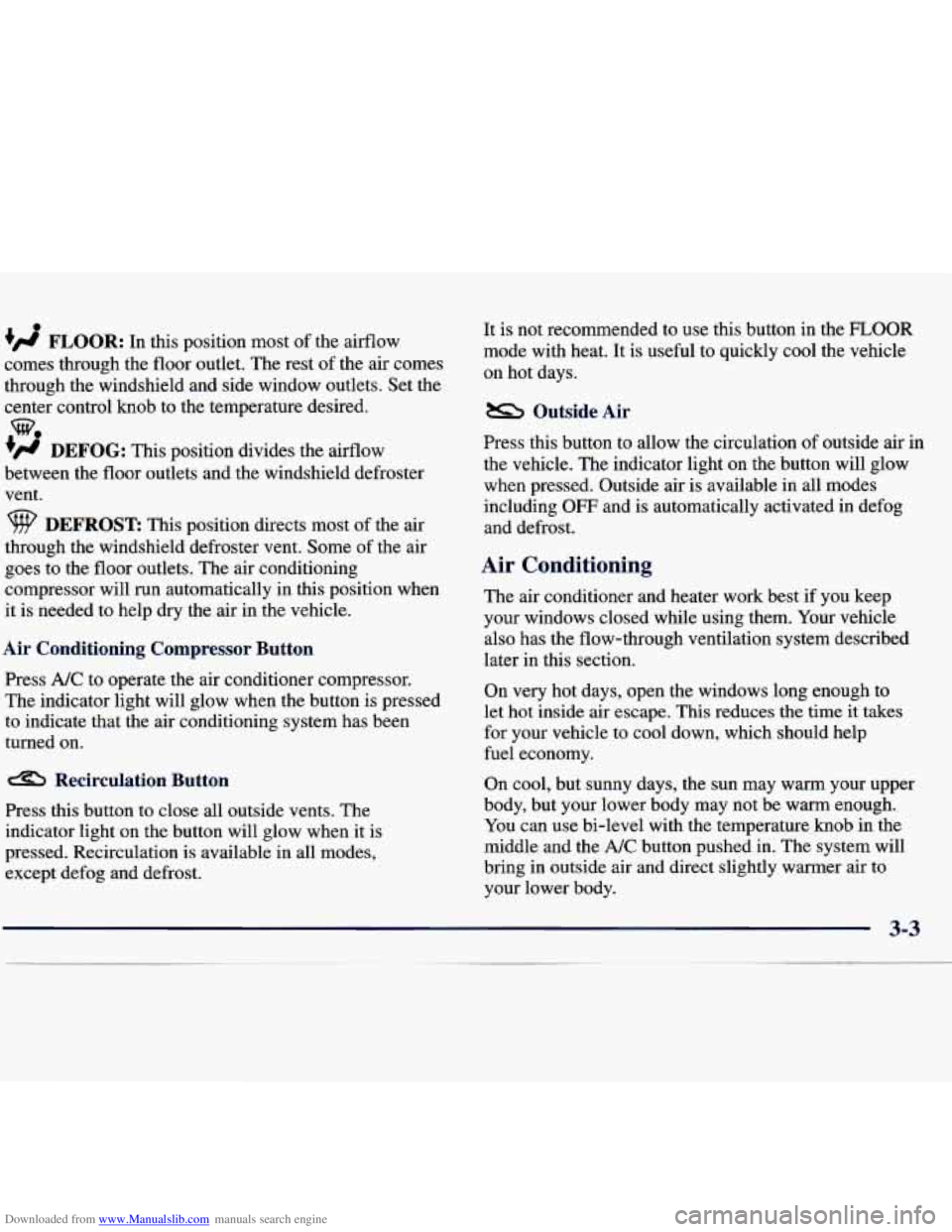
Downloaded from www.Manualslib.com manuals search engine 0
+# FLOOR: In this position most of the airflow
comes through the floor outlet. The rest of the air comes
through the windshield and side window outlets. Set the
center control knob to the temperature desired.
+' DEFOG: This position divides the airflow
between the floor outlets and the windshield defroster
vent.
9 DEFROST This position directs most of the air
through the windshield defroster vent. Some
of the air
goes
to the floor outlets. The air conditioning
compressor will run automatically in this position when
it is needed to help dry the air in the vehicle.
w0
Air Conditioning Compressor Button
Press A/C to operate the air conditioner compressor.
The indicator light will glow when the button is pressed
to indicate that the air conditioning system has been
turned on.
Recirculation Button
Press this button to close all outside vents. The
indicator light on the button will glow when it is
pressed. Recirculation is available in all modes,
except defog and defrost. It is not recommended to use this button
in the
FLOOR
mode with heat. It is useful to quickly cool the vehicle
on hot days.
Outside Air
Press this button to allow the circulation of outside air in
the vehicle. The indicator light on the button will glow
when pressed. Outside air is available in all modes
including
OFF and is automatically activated in defog
and defrost.
Air Conditioning
The air conditioner and heater work best if you keep
your windows closed while using them. Your vehicle
also has the flow-through ventilation system described
later in this section.
On very hot days, open the windows long enough to
let hot inside air escape. This reduces the time it takes
for your vehicle to cool down, which should help
fuel economy.
On cool, but sunny days, thc
--m may warm your upper
body, but your lower body
may not be warm enough.
You can use bi-level with the temperature knob in the
middle and the
A/C button pushed in. The system will
bring in outside air and direct slightly warmer air to
your lower body.
Page 182 of 362
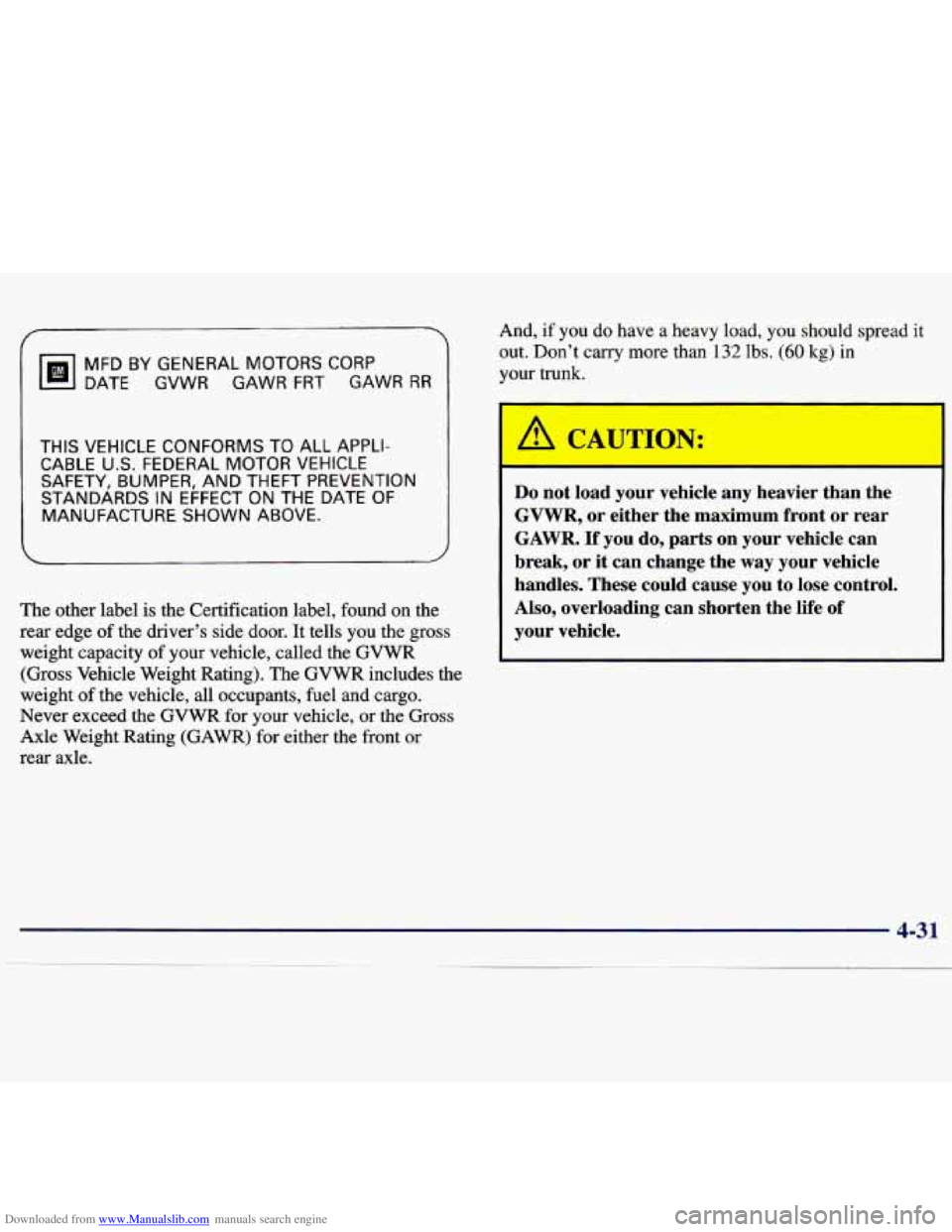
Downloaded from www.Manualslib.com manuals search engine #b BY GENERAL MOTORS CORP
DATE GVWR GAWR FRI GAWR RR
THIS VEHICLE CONFORMS TO ALL APPLI-
CABLE U.S. FEDERAL
MOTOR VEHICLE
SAFETY,
BUMPER, AND THEFT PREVENTION
STANDARDS
IN EFFECT ON THE DATE OF
MANUFACTURE SHOWN ABOVE.
The other label is the Certification label, found on the
rear edge
of the driver’s side door. It tells you the gross
weight capacity
of your vehicle, called the GVWR
(Gross Vehicle Weight Rating). The GVWR includes the
weight
of the vehicle, all occupants, fuel and cargo.
Never exceed the
GVWR for your vehicle, or the Gross
Axle Weight Rating (GAWR) for either the front or
rear axle. And,
if you do have a heavy load, you should spread it
out. Don’t carry more than
132 lbs. (60 kg) in
your trunk.
A CAUTION:
Do not load your vehicle any heavier than the
GVWR, or either the maximum front or rear
GAWR. If you do, parts on your vehicle can
break, or it can change the way your vehicle handles. These could cause you
to lose control.
Also, overloading can shorten the life of
your vehicle.
Page 184 of 362
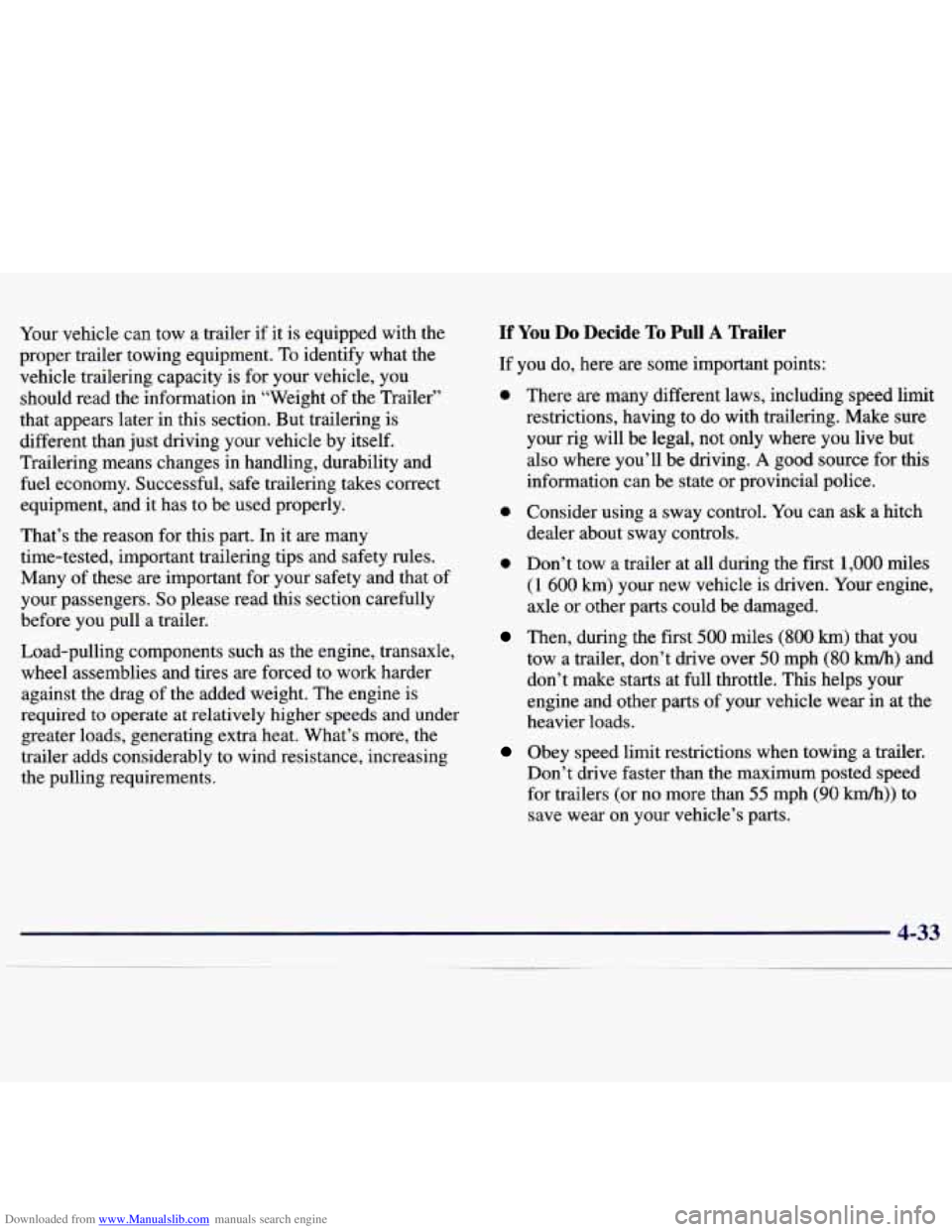
Downloaded from www.Manualslib.com manuals search engine Your vehicle can tow a trailer if it is equipped with the
proper trailer towing equipment. To identify what the
vehicle trailering capacity is for your vehicle, you
should read the information in “Weight of the Trailer”
that appears later in this section. But trailering
is
different than just driving your vehicle by itself.
Trailering means changes in handling, durability and
fuel economy. Successful, safe trailering takes correct
equipment, and
it has to be used properly.
That’s the reason for this part. In it
are many
time-tested, important trailering tips and safety rules.
Many of these are important for your safety and that
of
your passengers. So please read this section carefully
before you pull a trailer.
Load-pulling components such as the engine, transaxle,
wheel assemblies and tires are forced to work harder
against the drag
of the added weight. The engine is
required to operate
at relatively higher speeds and under
greater loads, generating extra heat. What’s more, the
trailer adds considerably to wind resistance, increasing
the pulling requirements.
If You Do Decide To Pull A Trailer
If you do, here are some important points:
0 There are many different laws, including speed limit
restrictions, having to do with trailering. Make sure
your rig will be legal, not only where you live but
also where you’ll be driving.
A good source for this
information can be state or provincial police.
0 Consider using a sway control. You can ask a hitch
dealer about sway controls.
0 Don’t tow a trailer at all during the first 1,000 miles
(1 600 km) your new vehicle is driven. Your engine,
axle or other parts could be damaged.
Then, during the first 500 miles (800 km) that you
tow a trailer, don’t drive over
50 mph (80 km/h) and
don’t make starts at full throttle. This helps your
engine and other parts
of your vehicle wear in at the
heavier loads.
Obey speed limit restrictions when towing a trailer.
Don’t drive faster than the maximum posted speed
for trailers (or no more than
55 mph (90 km/h)) to
save wear on your vehicle’s parts.
4-33
~
Page 226 of 362
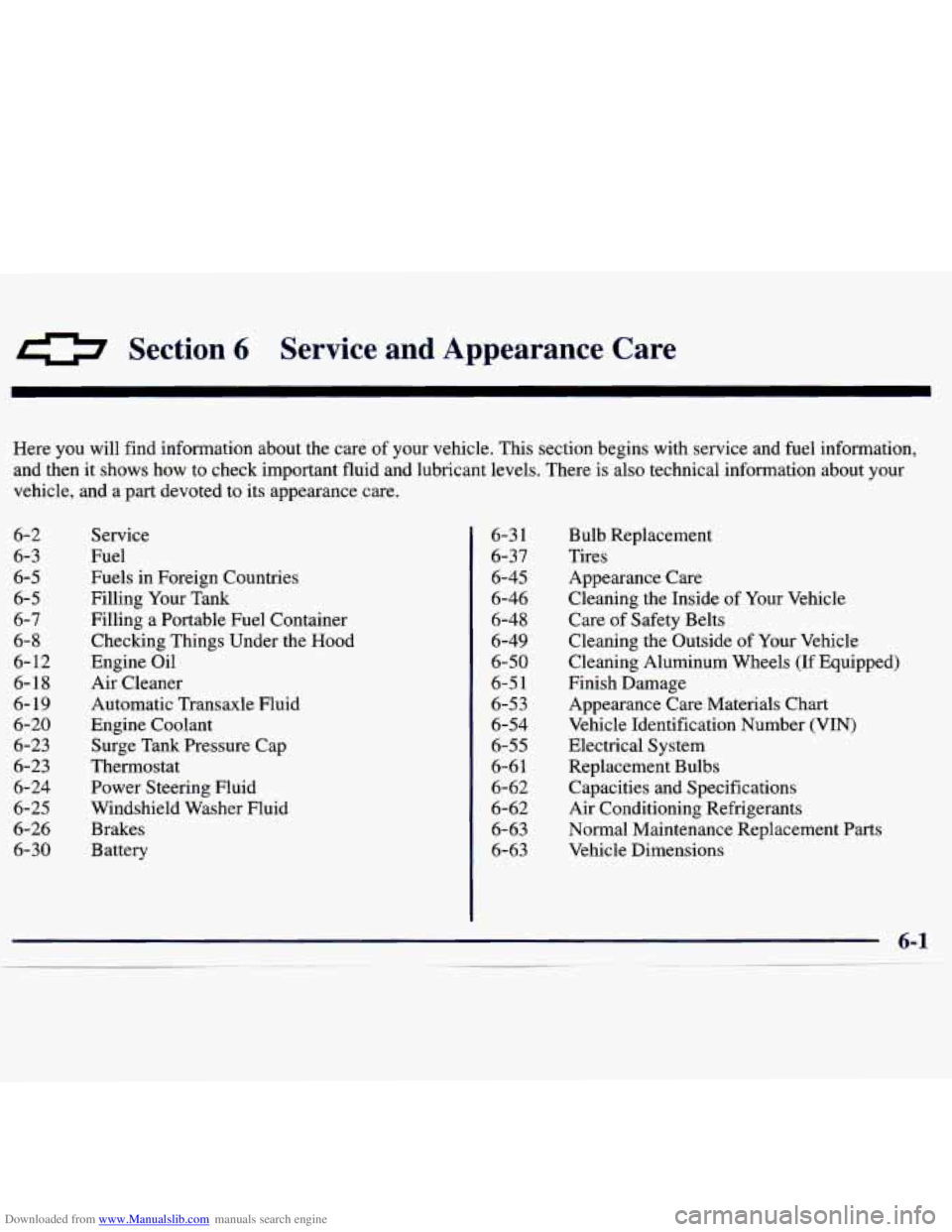
Downloaded from www.Manualslib.com manuals search engine Section 6 Service and Appearance Care
Here you will find information about the care of your vehicle. This section begins with service and fuel information,
and then it
shows how to check important fluid and lubricant levels. There is also technical information about your
vehicle, and a part devoted to its appearance care.
6-2
6-3
6-5
6- 5
6-7
6- 8
6- 12
6-18 6- 19
6-20
6-23
6-23
6-24
6-25
6- 26
6-30 Service
Fuel
Fuels in Foreign Countries
Filling Your Tank
Filling a Portable Fuel Container
Checking Things Under the Hood
Engine Oil
Air Cleaner
Automatic Transaxle Fluid
Engine Coolant
Surge Tank Pressure Cap
Thermostat
Power Steering Fluid
Windshield Washer Fluid
Brakes
Battery 6-3
1
6-37
6-45
6-46
6-48
6-49
6-50
6-5 1 6-53
6-54
6-55
6-6
1
6-62
6-62
6-63
6-63 Bulb Replacement
Tires Appearance Care
Cleaning the Inside of Your Vehicle
Care of Safety Belts
Cleaning the Outside of Your Vehicle
Cleaning Aluminum Wheels (If Equipped)
Finish Damage Appearance Care Materials Chart
Vehicle Identification Number (VIN)
Electrical System
Replacement Bulbs Capacities and Specifications
Air Conditioning Refrigerants
Normal Maintenance Replacement Parts
Vehicle Dimensions
Page 231 of 362
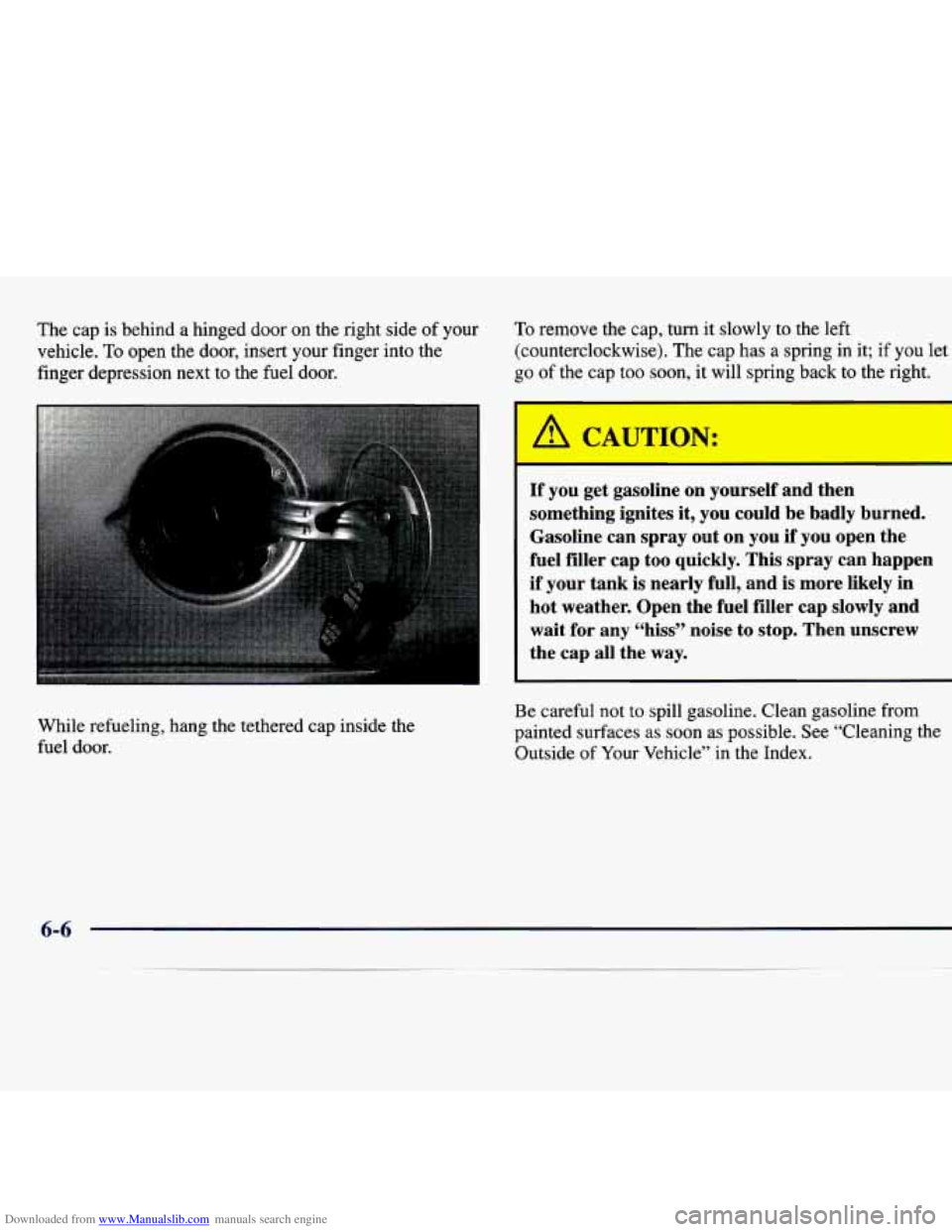
Downloaded from www.Manualslib.com manuals search engine The cap is behind a hinged door on the right side of your
vehicle.
To open the door, insert your finger into the
finger depression next to the fuel door.
To remove the cap, turn it slowly to the left
(counterclockwise). The cap has a spring in it; if you let
go of the cap too soon, it will spring back to the right.
While refueling, hang the tethered cap inside the
fuel door.
If you get gasoline on yourself and then
something ignites it, you could be badly burned.
Gasoline can spray out on you if you open the
fuel filler cap too quickly. This spray can happen
if your tank
is nearly full, and is more likely in
hot weather. Open the fuel filler cap slowly and
wait for any “hiss” noise to stop. Then unscrew
the cap all the
way.
Be careful not to spill gasoline. Clean gasoline from
painted surfaces as soon as possible. See “Cleaning the Outside of Your Vehicle” in the Index.
6-6
Page 232 of 362
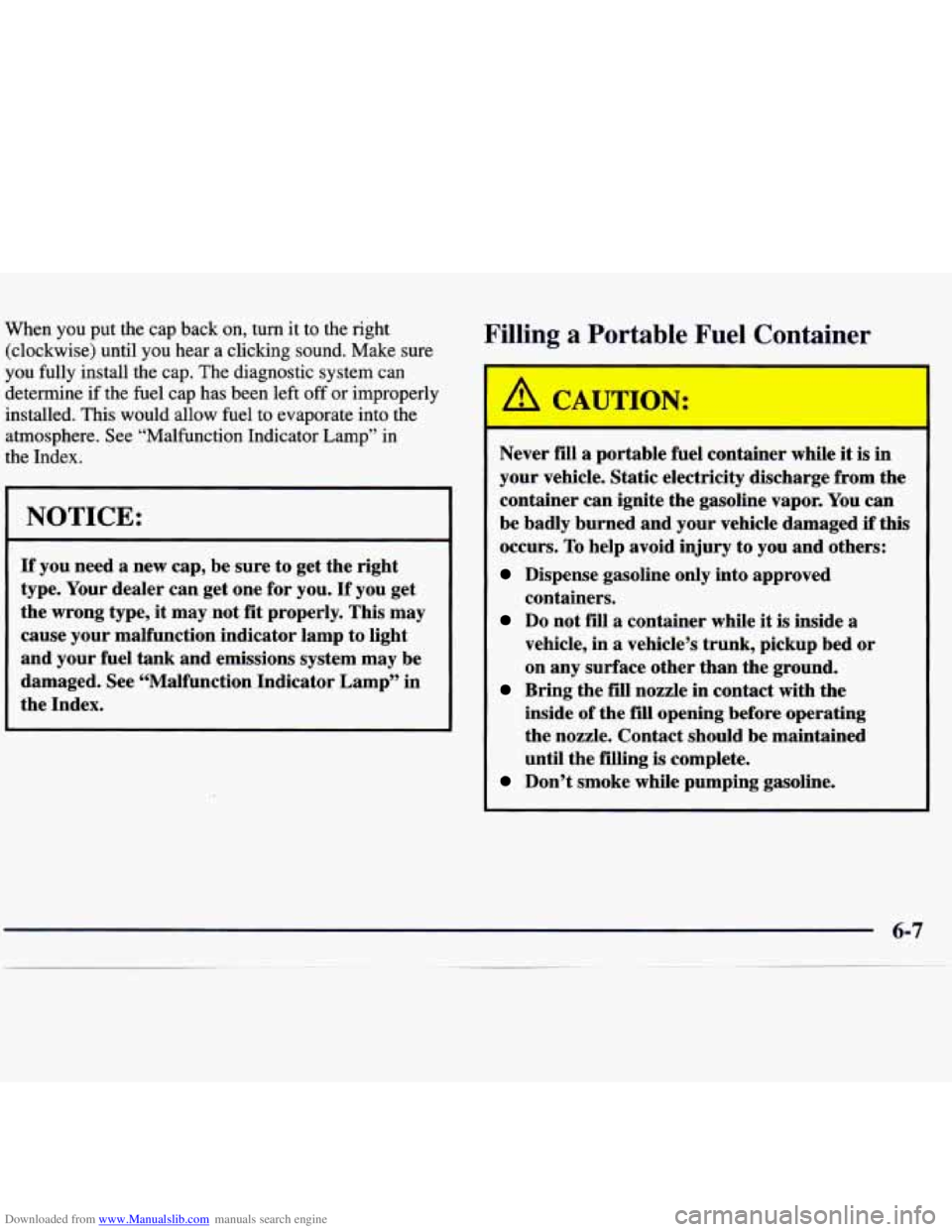
Downloaded from www.Manualslib.com manuals search engine When you put the cap back on, turn it to the right
(clockwise) until you
hear a clicking sound. Make sure
you fully install the cap. The diagnostic system can
determine if the fuel cap has been left
off or improperly
installed. This would allow fuel to evaporate into the
atmosphere. See “Malfunction Indicator Lamp” in
the Index.
NOTICE:
If you need a new cap, be sure to get the right
type. Your dealer can get one for you. If you get
the wrong type,
it may not fit properly. This may
cause your malfunction indicator lamp to light
and your fuel tank and emissions system may be
damaged. See “Malfunction Indicator Lamp” in
the Index.
Filling a Portable Fuel Container
Never fill a portable fuel container while it is in
your vehicle. Static electricity discharge from the
container can ignite the gasoline vapor. You can
be badly burned and your vehicle damaged
if this
occurs. To help avoid injury
to you and others:
Dispense gasoline only into approved
containers.
Do not fill a container while it is inside a
vehicle, in a vehicle’s trunk, pickup bed or
on any surface other than the ground.
inside
of the fill opening before operating
the nozzle. Contact should be maintained
until the filling
is complete.
Bring the fill nozzle in contact with the
Don’t smoke while pumping gasoline.